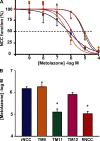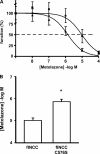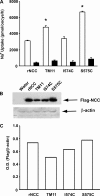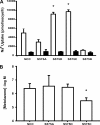A single residue in transmembrane domain 11 defines the different affinity for thiazides between the mammalian and flounder NaCl transporters
- PMID: 20719978
- PMCID: PMC2980407
- DOI: 10.1152/ajprenal.00412.2010
A single residue in transmembrane domain 11 defines the different affinity for thiazides between the mammalian and flounder NaCl transporters
Abstract
Little is known about the residues that control the binding and affinity of thiazide-type diuretics for their protein target, the renal Na(+)-Cl(-) cotransporter (NCC). Previous studies from our group have shown that affinity for thiazides is higher in rat (rNCC) than in flounder (flNCC) and that the transmembrane region (TM) 8-12 contains the residues that produce this difference. Here, an alignment analysis of TM 8-12 revealed that there are only six nonconservative variations between flNCC and mammalian NCC. Two are located in TM9, three in TM11, and one in TM12. We used site-directed mutagenesis to generate rNCC containing flNCC residues, and thiazide affinity was assessed using Xenopus laevis oocytes. Wild-type or mutant NCC activity was measured using (22)Na(+) uptake in the presence of increasing concentrations of metolazone. Mutations in TM11 conferred rNCC an flNCC-like affinity, which was caused mostly by the substitution of a single residue, S575C. Supporting this observation, the substitution C576S conferred to flNCC an rNCC-like affinity. Interestingly, the S575C mutation also rendered rNCC more active. Substitution of S575 in rNCC for other residues, such as alanine, aspartate, and lysine, did not alter metolazone affinity, suggesting that reduced affinity in flNCC is due specifically to the presence of a cysteine. We conclude that the difference in metolazone affinity between rat and flounder NCC is caused mainly by a single residue and that this position in the protein is important for determining its functional properties.
Figures








Similar articles
-
Affinity-defining domains in the Na-Cl cotransporter: a different location for Cl- and thiazide binding.J Biol Chem. 2006 Jun 23;281(25):17266-17275. doi: 10.1074/jbc.M602614200. Epub 2006 Apr 19. J Biol Chem. 2006. PMID: 16624820
-
The Na+:Cl- cotransporter is activated and phosphorylated at the amino-terminal domain upon intracellular chloride depletion.J Biol Chem. 2006 Sep 29;281(39):28755-63. doi: 10.1074/jbc.M603773200. Epub 2006 Aug 3. J Biol Chem. 2006. PMID: 16887815
-
Functional differences between flounder and rat thiazide-sensitive Na-Cl cotransporter.Am J Physiol Renal Physiol. 2002 Apr;282(4):F599-607. doi: 10.1152/ajprenal.00284.2001. Am J Physiol Renal Physiol. 2002. PMID: 11880320
-
Transport and thiazide-inhibition mechanisms of the Na-Cl cotransporter: a structural perspective.Curr Opin Nephrol Hypertens. 2025 Sep 1;34(5):440-449. doi: 10.1097/MNH.0000000000001099. Epub 2025 Jul 3. Curr Opin Nephrol Hypertens. 2025. PMID: 40575829 Free PMC article. Review.
-
Molecular insights from dysregulation of the thiazide-sensitive WNK/SPAK/NCC pathway in the kidney: Gordon syndrome and thiazide-induced hyponatraemia.Clin Exp Pharmacol Physiol. 2013 Dec;40(12):876-84. doi: 10.1111/1440-1681.12115. Clin Exp Pharmacol Physiol. 2013. PMID: 23683032 Review.
Cited by
-
The European Eel NCCβ Gene Encodes a Thiazide-resistant Na-Cl Cotransporter.J Biol Chem. 2016 Oct 21;291(43):22472-22481. doi: 10.1074/jbc.M116.742783. Epub 2016 Sep 1. J Biol Chem. 2016. PMID: 27587391 Free PMC article.
-
Kidney ion handling genes and their interaction in blood pressure control.Biosci Rep. 2022 Nov 30;42(11):BSR20220977. doi: 10.1042/BSR20220977. Biosci Rep. 2022. PMID: 36305246 Free PMC article. Review.
-
The Post-Translational Modification Networking in WNK-Centric Hypertension Regulation and Electrolyte Homeostasis.Biomedicines. 2022 Sep 2;10(9):2169. doi: 10.3390/biomedicines10092169. Biomedicines. 2022. PMID: 36140271 Free PMC article. Review.
-
Molecular Physiological Evidence for the Role of Na+-Cl- Co-Transporter in Branchial Na+ Uptake in Freshwater Teleosts.Int J Mol Sci. 2023 Apr 1;24(7):6597. doi: 10.3390/ijms24076597. Int J Mol Sci. 2023. PMID: 37047570 Free PMC article.
-
Insulin increases the functional activity of the renal NaCl cotransporter.J Hypertens. 2013 Feb;31(2):303-11. doi: 10.1097/HJH.0b013e32835bbb83. J Hypertens. 2013. PMID: 23303355 Free PMC article.
References
-
- Chen NH, Reith ME, Quick MW. Synaptic uptake and beyond: the sodium- and chloride-dependent neurotransmitter transporter family SLC6. Pflugers Arch 447: 519–531, 2004. - PubMed
-
- Chobanian AV, Bakris GL, Black HR, Cushman WC, Green LA, Izzo JL, Jr, Jones DW, Materson BJ, Oparil S, Wright JT, Jr, Roccella EJ. National Heart, Lung, and Blood Institute Joint National Committee on Prevention, Detection, Evaluation, and Treatment of High Blood Pressure; National High Blood Pressure Education Program Coordinating Committee. The Seventh Report of the Joint National Committee on Prevention, Detection, Evaluation, and Treatment of High Blood Pressure: the JNC 7 report. JAMA 289: 2560–2572, 2003. - PubMed
-
- De Jong JC, Willems PH, Mooren FJ, van den Heuvel LP, Knoers NV, Bindels RJ. The structural unit of the thiazide-sensitive NaCl cotransporter is a homodimer. J Biol Chem 278: 24302–24307, 2003. - PubMed
-
- Dumont JN. Oogenesis in Xenopus laevis (Daudin). Stages of oocyte development in laboratory maintained animals. J Morphol 136: 153–180, 1970. - PubMed
Publication types
MeSH terms
Substances
Grants and funding
LinkOut - more resources
Full Text Sources

